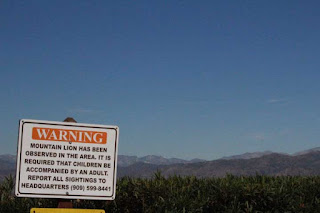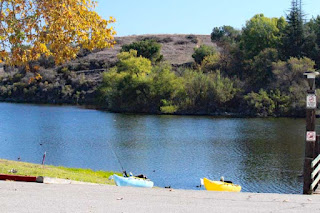NOTE: Best to view blog on computer, however, to view full blog on phone scroll to bottom of the blog and click on “View Web Version”. You can click on the Google Maps tab at the top and click on Year 5, Year 4, Year 3, Year 2 or Year 1 to see where we have been. You can click on the markers on the map to view the RV Parks we stayed at.
California–Chapter 3-October 26, 2015 through November 13, 2015
This is Chapter 3
of four chapters of our 6-month journey through California.
Chapter 3
includes: Three Rivers, Sequoia National
Park & Kings Canyon National Park and San Dimas and Hollywood.
Three Rivers - October 26, 2015 through November 2, 2015
We stayed at Sequoia RV Ranch
as it was near Sequoia and Kings Canyon National Parks. See the bear between the trees on the right side of our RV!
We discovered
there were bears in this RV park! Mike was setting up the RV and Sharon grabbed
her camera to take photos of the birds.
A man stopped on his bike and asked
Sharon if she had seen the bears. Sharon nervously replied – what bears! There were
wild black bears here in search of acorns and water from the Kaweah River, both
of which were plentiful in our RV Park. He pointed and a few hundred feet from
our RV was a bear!
Later we saw that
there were four bears in the park. Black bears come in more colors than any
other North American mammal. One was cinnamon in color, one was brown and two
were black. For the first time, we saw a bear climb a tree near our RV. The
bears were not aggressive or interested in people, dogs or trash; they just
wanted to fatten up for the winter! It was amazing to watch the bears’ behavior
during our stay. Sharon had Mike set up our game camera outside the RV. Before
we left, one of the last photos was of a bear at night passing by our RV!
The bears were
being forced down from the higher elevations due to fires and a four-year drought
that have the local bear population stressed and in a state of starvation and
dehydration. We discovered that all around town, desperate bears were climbing
up onto rooftops, into treetops, coming onto decks, and traipsing through yards
in search of more acorns. Acorns are the food of choice and are among the most
abundant food resources in California.
We went into the
local information center in town. Looked around the museum to learn some of the history of the area.
Mike noticed a framed photograph of a bear in a tree. He asked the man in the information center where the photo was taken. The man said he took the photo and pointed across the street to a tree. We were not expecting to see a bear perched across a branch in that same tree! It was so close along the main highway that we were shocked! Sharon was excited to get a few photos! While another tourist walked up to the tree, Sharon kept a safe distance! The bear would grab the branches, pull them to him and strip them of their leaves!

By the time we
left, the bears in our RV Park had eaten so many acorns, their bellies were
touching the ground!
Sequoia National Park & Kings Canyon
National Park
Sequoia National Park and
Kings Canyon National Park are twin national parks located on the southern end
of California’s Sierra Nevada Mountains. Together the parks preserve 1,353
square miles, contains the world’s largest tree (General Sherman), and includes
the Lower 48’s tallest peak (Mt. Whitney). The parks hold one-third of the
world’s naturally occurring giant sequoias which are members of the Redwood
family, and host more than 1.6 million people from around the world. The vast
circumference of the giant sequoia trees is truly a wonder to behold. Their
trunks dwarf anyone who stands beside them.


Literally carved into the side of cliffs, the road to Kings Canyon was awesome, with jaw-dropping views.
We first hiked in Kings Canyon National Park, but due to a fire sparked by lightning, some of the roads in the park were closed. Kings Canyon was established on March 4, 1940 and is home to one of the deepest canyons in America. We hiked on the Grant Tree Trail to Grant Grove to see General Grant, one of the world’s largest trees. The tree is also a living national shrine.
While Sharon drove around a curve on Generals Highway, she spotted a tarantula spider crossing the road! Mike yelled “stop.” Sharon pulled over and Mike hopped out with camera in hand and stooped in the middle of the road to take photos! Tarantulas live a long time. Females may live for 25-30 years while males don’t make it past the age of 10 or 12. A male tarantula can travel up to 50 miles while seeking a female. In case you didn’t know, tarantulas have eight eyes, but don’t rely on them while hunting. Instead, tarantulas sense prey using the vibration-detecting hairs that cover their bodies. Tarantulas give Sharon the creeps! But Mike was curious and fascinated!
At one point we stopped for lunch in the Jeep. Looking in our review mirrors we noticed tourists all around the Jeep taking photos!! They were French tourists from a tour bus who found something interesting about our Jeep. We don’t think they knew we were inside! Did they find our kayaks and bikes interesting, or could it be our Florida license plate with the bear! We had no clue! It was quite funny!
The Historic Gamlin Cabin on Grant Tree
Trail was built in 1872 by Israel Gamlin, who with his brother Thomas filed a
timber claim to 160 acres within Grant Grove. They quartered here until 1878
while grazing cattle in the mountains. After General Grant National Park was
established in 1890. The cabin was used as a storehouse by the U.S. Cavalry who
patrolled the park until 1913. Later it became the quarters of the first park
ranger stationed here.

While neither the tallest nor the widest, the General Sherman Tree is considered the largest living tree in the world because of its volume. It weighs approximately 2.7 million pounds, and it is believed to be approximately 2,200 years old. Its height is nearly 275 feet, and its circumference at ground level is 102.6 feet. The diameter of its largest branch is 6.8 feet.
You really feel
the enormity of the giant sequoia when you see the “Tunnel Log.” The base
diameter is 21 feet, the length is 275 feet and the tunnel is 8 feet high and
17 feet wide.
The Buttress Tree
fell without warning on June 3, 1959. The weather was clear with no wind.
Sequoias lose their balance and fall when their shallow root systems are
weakened by fire, erosion, or very wet soil. The Buttress Tree is 272 feet long
with a base diameter of 20 feet. Its estimated age is 2,300 years.
The Giant Sentinel Tree greeted us at the Giant Forest Museum where we learned the story of the Giant Forest.
Historic Visalia
Visalia is the
Gateway to the Sequoia and Kings Canyon National Parks. On our last day we took
a trolley tour around town. Visalia’s first real contact with the outside world
was on October 8, 1858, when the first Butterfield stage, straining to make a
record run with the U.S. mail from St. Louis to San Francisco, arrived in town.
Its only passenger was W. L. Ormsby, special correspondent for the New York
Herald, who wrote a diary later published in the Herald.
The Visalia Fox Theatre is a landmark movie palace and theater that opened in 1930 as a part of the Fox Theatre chain. It was converted to a three-screen multiplex in 1976.
San Dimas – November 2, 2015 through November 13, 2015
We stayed at East Shore RV
Park from November 2, 2015 through November 13, 2015. The park is located on
the banks of Puddingstone Lake, which is stocked with trout and bass several
times a year. As we drove into the park, we noticed a warning sign that
mountain lions have been spotted in the area! And a notice that coyotes were
also in the area! Of course, Sharon asked Mike to mount the game camera just in
case! We had a great view!
Kayaking on Puddingstone Lake
Today, we packed
lunch and drinks and took a short drive to Frank G. Bonelli Regional Park in
San Dimas. The 1,975 acres park surrounding Puddingstone Lake offer a variety
of recreational activities. We launched our kayaks for a day on the lake.
Completed in 1928 at a cost of one million dollars, the dam was originally built as a flood control facility to impound storm run-off and replenish underground water supplies. The dam created a 250-acre lake. In 1953 the 150-acre Puddingstone Reservoir was designated as a “Recreational and Fishing Area.” It was stocked with fish by the state fish and game commission. Mike paddled closer to the dam as Sharon stayed a safe distance away!
The views of the surrounding San Jose Hills made for some nice photos. And there were birds everywhere – osprey scoping out their next meal, ducks walking on water and wading birds ready to spear a fish. Mike fishing for his next catch and release!

Hollywood Tours
We weren’t too far
from Los Angeles, so we got tickets for a Paramount Pictures Studio Tour and a Hollywood
Dream Tour.
One day we drove two
hours to Los Angeles and the bumper to bumper morning traffic was horrendous!
Once we arrived, we took the Starline Hop On Hop Off trolley and went
sightseeing through Hollywood, Beverly Hills and Santa Monica. We saw the
iconic Hollywood sign; The Chinese Theatre, a famous landmark; Rodeo Drive, the
two-mile street that epitomizes the glamour Beverly Hills is famous for; Sunset
Strip with nightclubs, eateries, boutique shopping and music halls and a great
place for people watching.






We walked up to
the storefront where our Hollywood Dream Tour would begin. We looked at each
other and thought we made a big mistake!! We waited outside of a sleezy store
with its website www.playmatesofhollywood.net plastered to the
front of the building! Our tour guide was a little shady too! But we thought
“this is Hollywood” and hopped into the open-air van!
The driver was a friendly character. We had to laugh at the funny behind-the-scenes tales!! For two hours, we explored the hot spots, beautiful Mulholland Drive, neighborhoods of Beverly Hills, celebrity homes (couldn’t tell you whose house is whose); It was nice to get out at the overlook to see the Hollywood sign and we even stopped at a lemonade stand! It was a fun way to spend the day!




We were greeted by
the tour guide and hopped on a golf cart to take a behind-the-scenes look at
the Paramount studio lot. We stepped into the world of the industry’s top talent, producers, and crew who create today’s award-winning television and feature films. We would discover Hollywood’s first major movie studio, iconic locations like the Bronson Gate, New York Street Backlot and the Prop Warehouse.
This concludes
Chapter 3 of our first adventure through California. The journey continues in
Chapter 4 in our next blog posting. Stay tuned!
Keep in touch!
Enjoy the rest of your summer!
Mike & Sharon
“Between every two pines is a doorway to a new world.”
John Muir





























































































































































































































